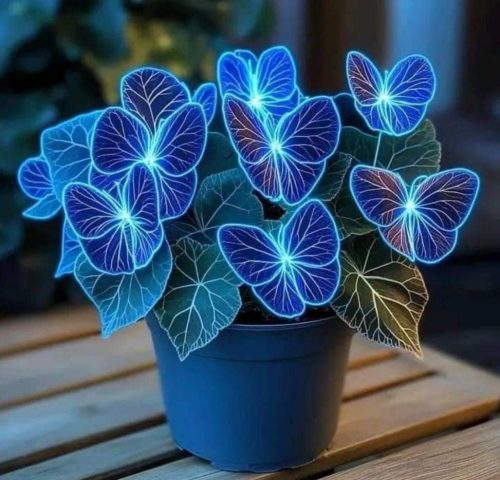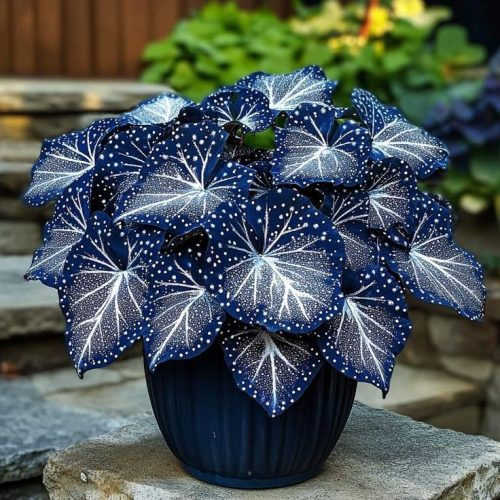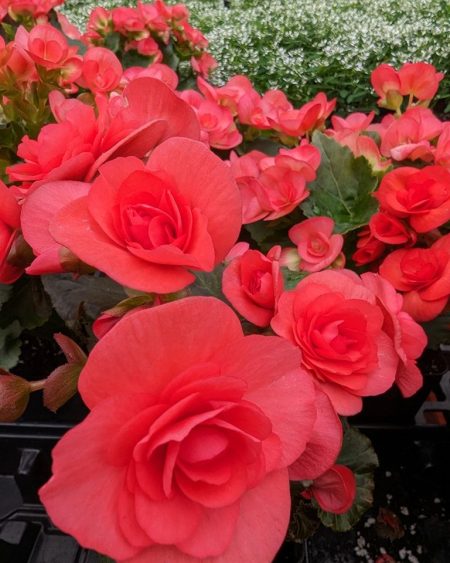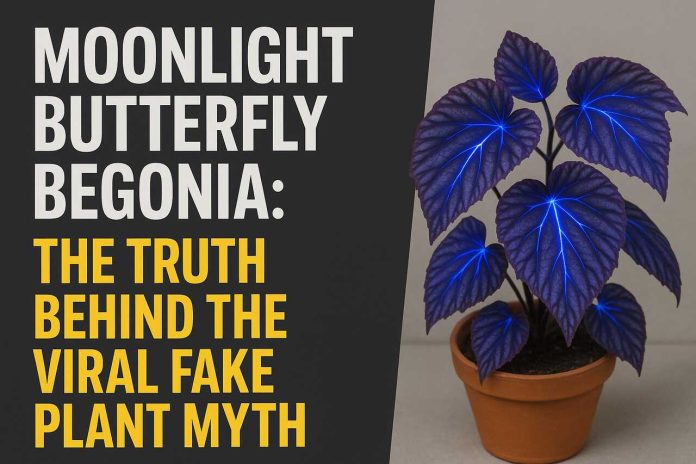Pre-Intro Summary
| Attribute | Details |
| Full Name | “Moonlight Butterfly Begonia” (often labeled Begonia ‘Moonlight Butterfly’) |
| Category | Ornamental houseplant / alleged Begonia cultivar |
| Function | Decorative foliage, marketed for its “butterfly-wing” leaves |
| Causes of Hype | Viral social-media posts, AI-generated plant photos, fake seed listings |
| Prevalence | Absent from all major horticultural databases; confirmed non-existent |
| Relevance | Highlights plant-hoax culture, AI image misuse, and consumer risk |
| Key Entities | Begonia genus, Begoniaceae family, Begonia rex, Begonia ‘Angel Wing’ |
| Related Topics | Fake rare plants, AI-generated imagery, cultivar verification, safe plant collecting |
Introduction
Every few months, the internet falls in love with a “new” plant so stunning it seems almost magical. In late 2024, one such specimen — the Moonlight Butterfly Begonia — spread across Facebook, Pinterest, and TikTok feeds. With its radiant, violet-blue leaves shaped like butterflies glowing in moonlight, it quickly captivated plant enthusiasts. Sellers on questionable websites even claimed to offer its seeds for sale.
But here’s the truth: the Moonlight Butterfly Begonia doesn’t exist. It is not registered in any botanical database, and its viral images are almost certainly AI-generated fabrications. This comprehensive guide uncovers how the myth began, why experts refute its authenticity, how you can protect yourself from plant scams, and which real begonias offer similar beauty without deception.
What Is the Moonlight Butterfly Begonia and Why Has It Gone Viral?

The “Moonlight Butterfly Begonia” refers to an alleged begonia cultivar featuring iridescent leaves shaped like butterflies. The viral photos depict shimmering petals in hues of indigo, lavender, and metallic blue — qualities rarely found in natural begonia foliage.
The craze began when users shared these striking images on Facebook and Instagram, often accompanied by captions like “This is NOT AI!” or “Seeds available now at IMSeeds.” As the photos circulated, online stores began exploiting the trend by advertising “Moonlight Butterfly Begonia seeds”, drawing in plant collectors eager to own a rare treasure.
Social media’s visual nature amplified the illusion. Platforms like Pinterest reward engagement with vibrant imagery, and AI-generated visuals thrive in that ecosystem. The combination of fantasy aesthetics and algorithmic virality created a perfect storm for deception.
Why Horticultural Experts Say the Moonlight Butterfly Begonia Does Not Exist

Botanists and horticultural registries have thoroughly investigated the claim and unanimously agree: there is no verified cultivar named ‘Moonlight Butterfly’ within the Begonia genus.
Professional horticulturists rely on official plant databases — repositories that record every registered plant cultivar worldwide. These include the Royal Horticultural Society (RHS) Plant Finder, the National Gardening Association (NGA) Plant Database, and the International Cultivar Registration Authority (ICRA) for Begoniaceae. None contain any record of such a plant.
Which Plant Databases Fail to List ‘Moonlight Butterfly’?
| Database / Registry | Result | Notes |
| Royal Horticultural Society (RHS) | ❌ No listing | RHS manages cultivar registration for ornamental plants. |
| National Gardening Association (NGA) | ❌ No listing | Extensive American registry for garden species. |
| International Plant Names Index (IPNI) | ❌ No listing | No botanical record or taxonomic description. |
| World Flora Online (WFO) | ❌ Absent | Confirms no botanical basis for the name. |
This total absence confirms the “Moonlight Butterfly Begonia” is not an accepted species, cultivar, or hybrid.
What Evidence Points to AI-Generated Images or Manipulation?
Visual forensic tools like Hive Moderation and AI or Not can detect synthetic image patterns. When analyzed, viral begonia images display hallmarks of generative AI, including:
- Symmetry anomalies (perfectly mirrored leaves or repeating patterns unnatural in organic growth).
- Lighting inconsistencies — soft luminescence not replicable under natural or grow-light conditions.
- Petiole irregularities — stems blend seamlessly into the background, suggesting algorithmic rendering.
- Lack of provenance — no photographs of the plant in nursery settings, botanical collections, or user-generated content beyond identical viral posts.
Together, these clues confirm that the Moonlight Butterfly Begonia exists only in pixels, not petals.
How to Identify Fake Plant Listings or “Too Good to Be True” Cultivars
Digital plant scams are now widespread, preying on collectors seeking exotic species. Before purchasing, use the following verification steps:
- Search the cultivar name in credible databases like RHS or NGA. Absence usually signals a fake.
- Reverse-image search the plant photo to see if it appears across unrelated listings or AI forums.
- Inspect the vendor’s domain — legitimate nurseries list physical addresses, certifications, and transparent return policies.
- Check for reviews or community warnings (Reddit, Garden.org, Facebook plant groups).
- Avoid paying through direct bank transfers; use buyer-protected methods such as PayPal or credit cards.
If a listing promises “rare luminous plants,” “impossible colors,” or “AI disclaimers”, treat it with skepticism. Authentic cultivars are usually sold via accredited nurseries or botanical gardens — not anonymous online seed shops.
What Are Realistic Begonia Alternatives With “Butterfly-Wing” Foliage?

While the Moonlight Butterfly Begonia is fictional, real begonias possess foliage so dramatic they rival the hoax in beauty. Here are verified cultivars with wing-like or iridescent leaves:
| Cultivar Name | Type | Leaf Traits | Light & Care |
| Begonia rex ‘Escargot’ | Rhizomatous | Spiral silver-green leaves resembling snail shells or wings | Bright indirect light, moderate humidity |
| Begonia ‘Angel Wing’ | Cane begonia | Elongated, glossy leaves with silver spots resembling wings | Partial shade, high humidity |
| Begonia ‘Fireworks’ | Rex begonia | Metallic purple and green foliage with vivid veining | Indirect light, well-draining soil |
| Begonia maculata (Polka Dot Begonia) | Cane | Olive-green leaves with white spots and red undersides | Bright filtered light |
| Begonia pavonina (Peacock Begonia) | Rhizomatous | True iridescent blue shimmer under certain light angles | Warm, humid environments |
Each of these real cultivars has been documented in horticultural literature and is available through reputable suppliers.
If Someone Tries to Market Seeds or Plants of the Moonlight Butterfly Begonia, What Should a Buyer Know?
If you encounter a seller advertising Moonlight Butterfly Begonia seeds, assume it’s fraudulent. Begonias do not grow true from seed for specific cultivars; they are propagated vegetatively through leaf or rhizome cuttings. Therefore, any vendor claiming to sell “seeds” of a patented cultivar is immediately suspicious.
Scam vendors often operate under names like “IMSeeds” or “Exotic Garden Pro,” using copied product descriptions, fabricated testimonials, and cloned photos. Victims have reported:
- Receiving unrelated seeds (e.g., grass or marigold).
- No delivery after payment.
- Data theft from entered credit card information.
Consumers should report such scams to e-commerce authorities or digital fraud hotlines. Supporting certified nurseries helps maintain transparency and protects the horticultural trade.
What Lessons Does the Moonlight Butterfly Begonia Case Teach About Plant Collecting, Social Media, and Botanical Literacy?
This viral phenomenon is more than a hoax — it’s a reflection of modern digital culture. The event exposes three critical lessons for plant lovers:
- AI Visual Deception Is Easy to Believe – Generative imagery now looks convincing enough to fool even seasoned collectors.
- Botanical Verification Matters – Without understanding how cultivars are named, registered, and propagated, consumers become easy targets.
- Community Vigilance Prevents Scams – Online garden forums and social media groups often debunk false listings faster than official channels.
The Moonlight Butterfly Begonia highlights the need for botanical literacy — the ability to distinguish between verified science and viral fiction. It also calls on digital platforms to moderate deceptive plant content that encourages consumer fraud.
Where to Find Credible Information and Trusted Sources When Purchasing Rare Plants
Before investing in “rare” species, check these trustworthy resources:
- Royal Horticultural Society (RHS) – authoritative cultivar listings and care guides.
- National Gardening Association (NGA) – searchable database with photos from verified growers.
- American Begonia Society – dedicated registry for authentic begonia hybrids.
- Botanic Gardens Conservation International (BGCI) – global plant taxonomy database.
- Reputable vendors like Logee’s, Steve’s Leaves, and Glasshouse Works specialize in legitimate rare foliage plants.
Bookmark these platforms as your first stop before buying or sharing photos of fantastical plants online.
Conclusion
The Moonlight Butterfly Begonia is a stunning example of how the digital era blurs the line between imagination and reality. What began as an AI-generated artwork became a viral myth that fooled thousands of plant enthusiasts. Yet, its popularity also sparked valuable discussions about authenticity, consumer protection, and the future of plant collecting in the age of AI.
By practicing botanical literacy — checking registries, questioning sources, and supporting verified sellers — gardeners can enjoy real beauty without deception. The truth is that nature already offers countless begonias with butterfly-like leaves; we don’t need digital illusions to be amazed.
FAQs
- Is there really a plant called Moonlight Butterfly Begonia?
No. There is no recognized begonia cultivar named Moonlight Butterfly. All images circulating online are digitally fabricated. - How do I know if a rare plant listing is legitimate?
Search the name in trusted databases (RHS, NGA), check vendor transparency, and look for provenance photos. Avoid vendors that only post viral imagery. - Can I buy seeds for Moonlight Butterfly Begonia?
No — any such offer is a scam. Real begonias are propagated from cuttings, not seeds of fantasy cultivars. - What real begonias look like butterfly wings?
Begonia rex, Begonia maculata, and Begonia ‘Angel Wing’ display dramatic foliage patterns reminiscent of wings. - How did AI contribute to the myth?
Generative AI tools created hyper-realistic plant photos that users shared as genuine, blurring the boundary between art and botany. - What should I do if I’ve already purchased fake seeds?
Contact your payment provider immediately, report the vendor to consumer protection authorities, and warn others through online communities.













